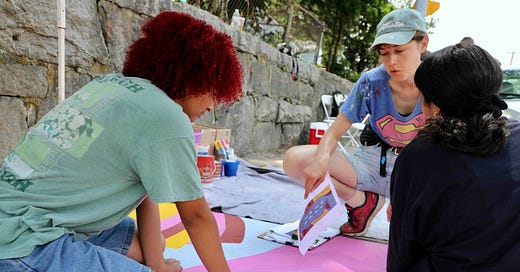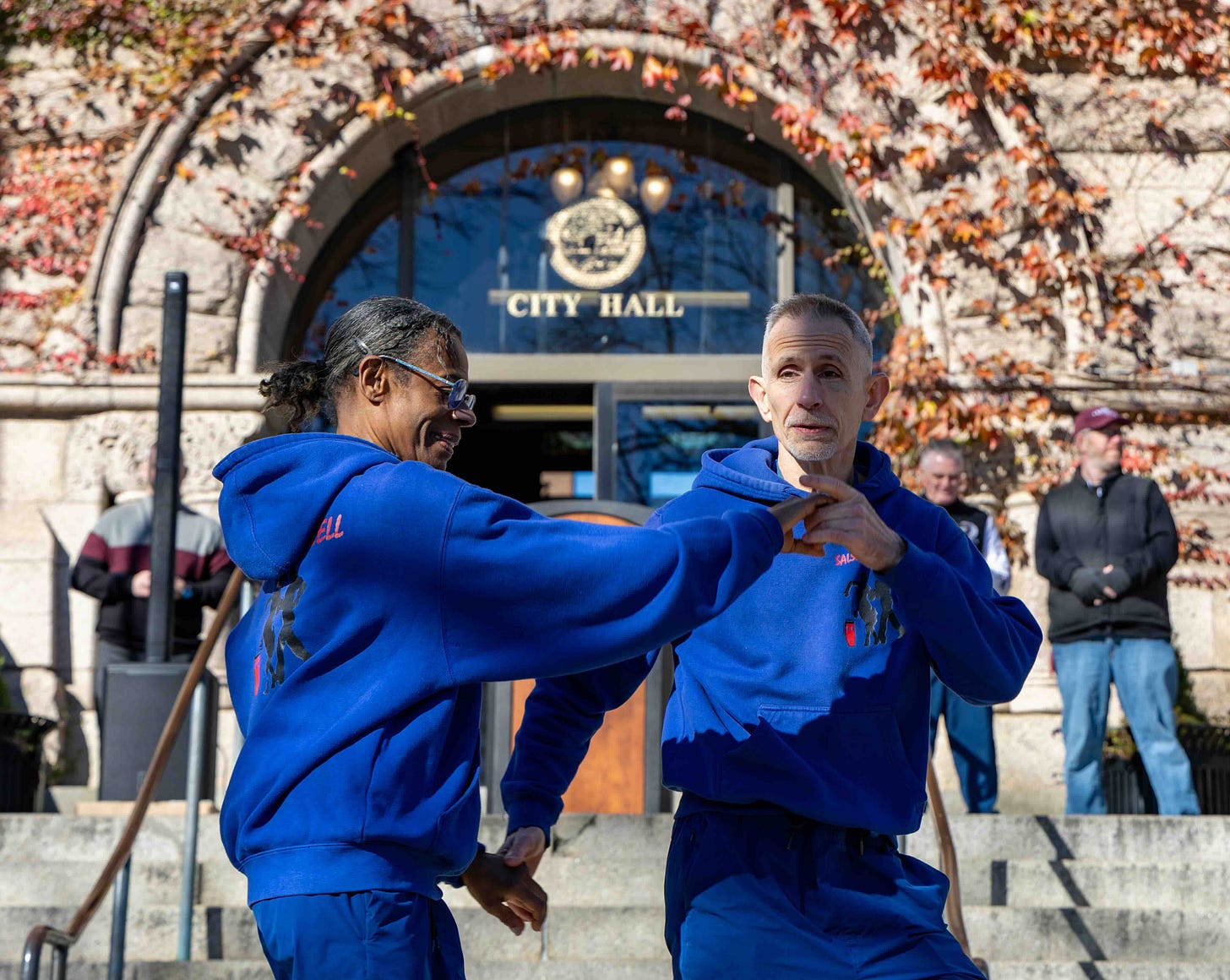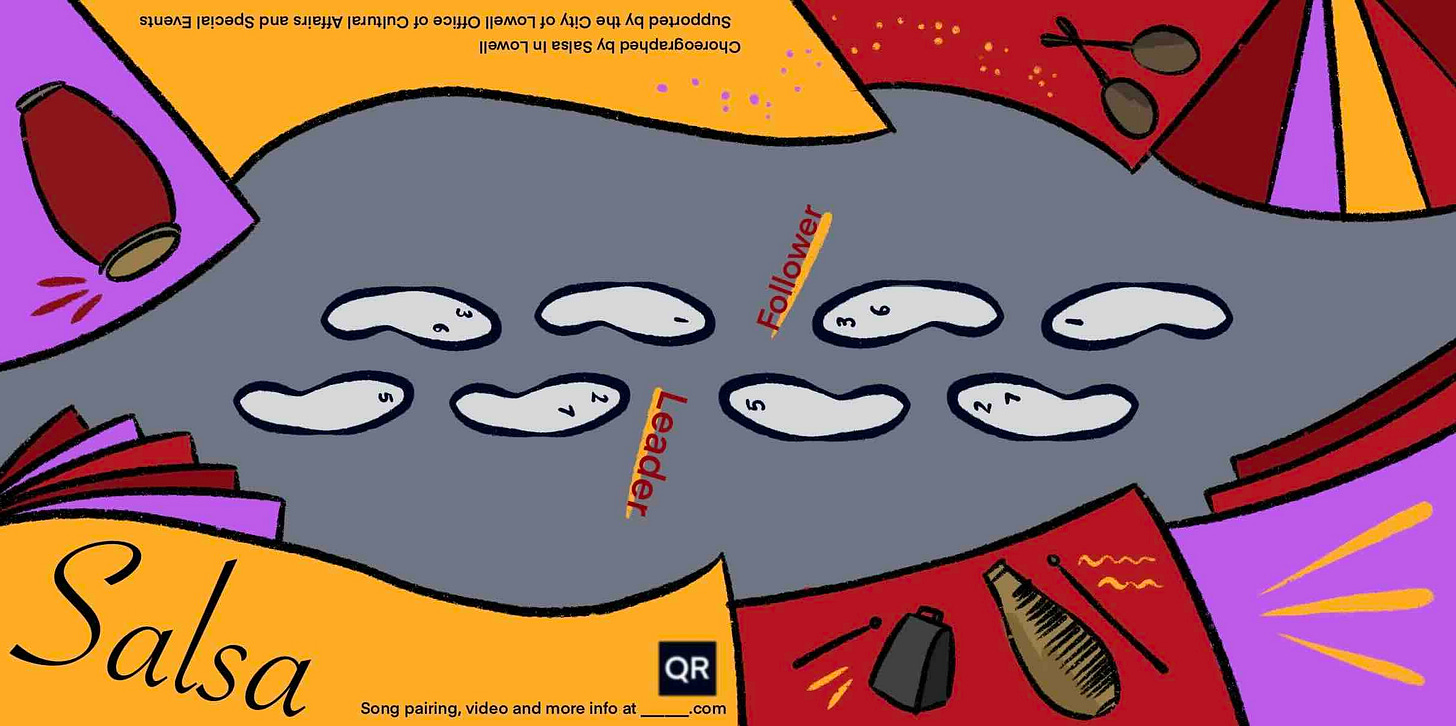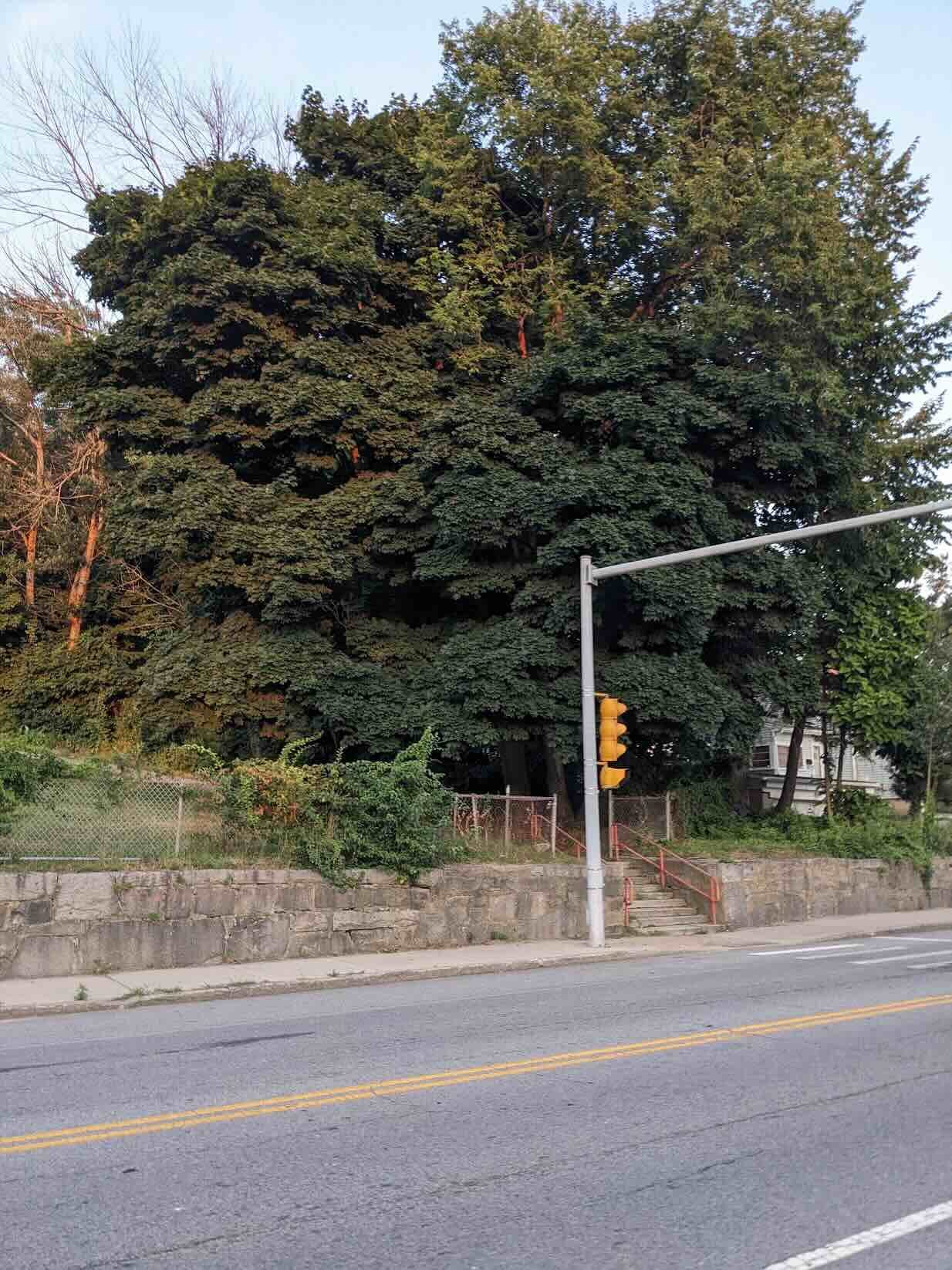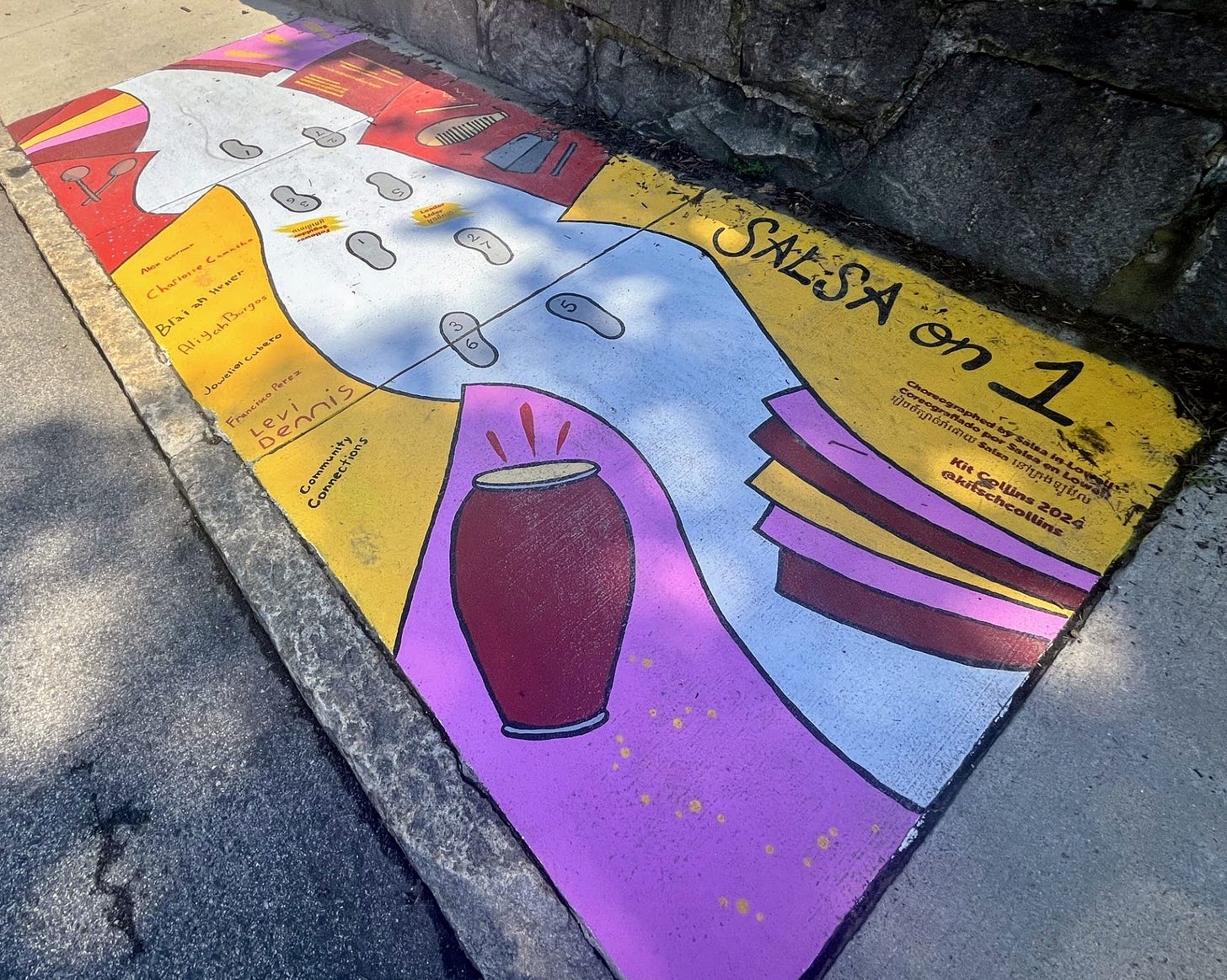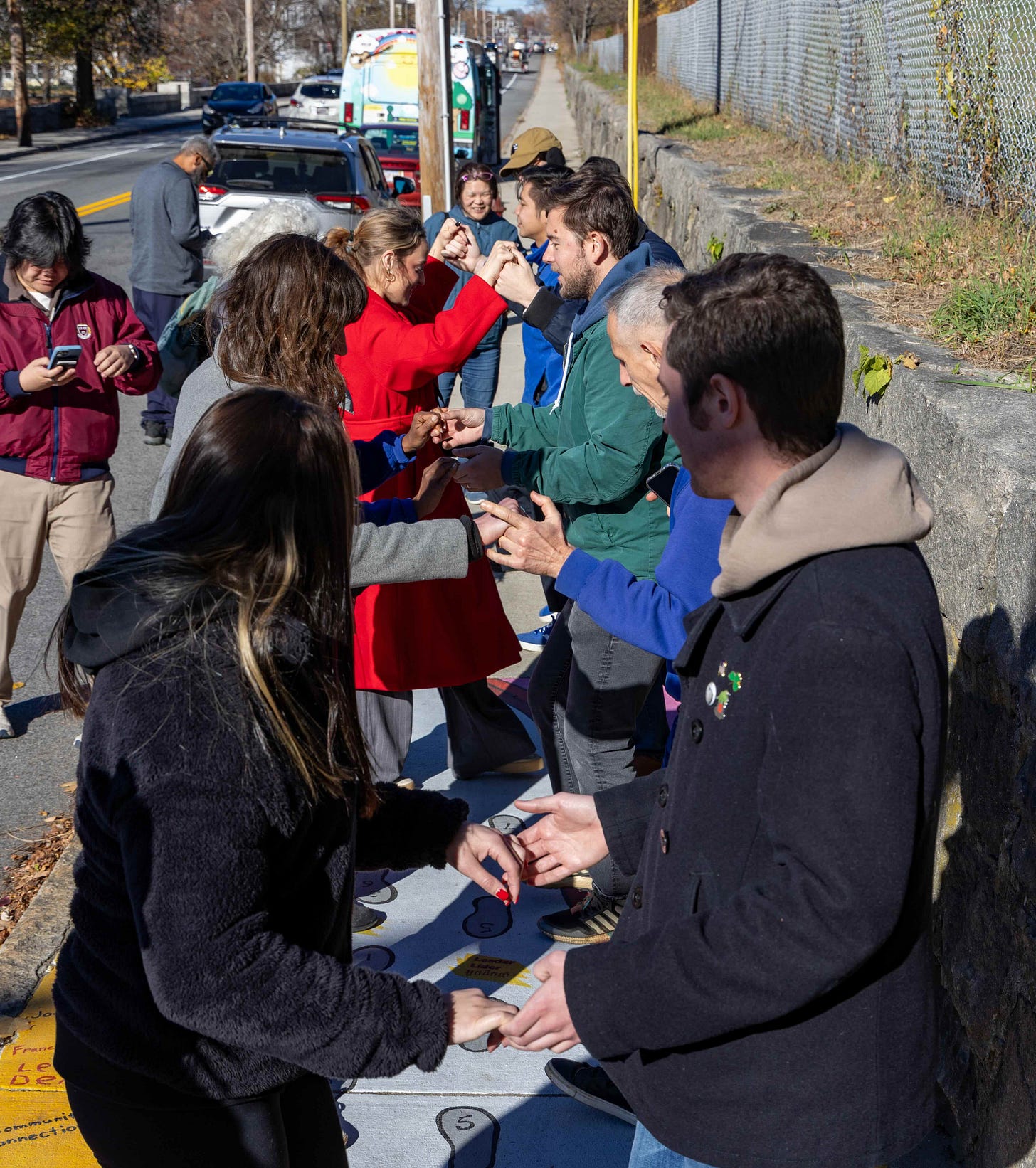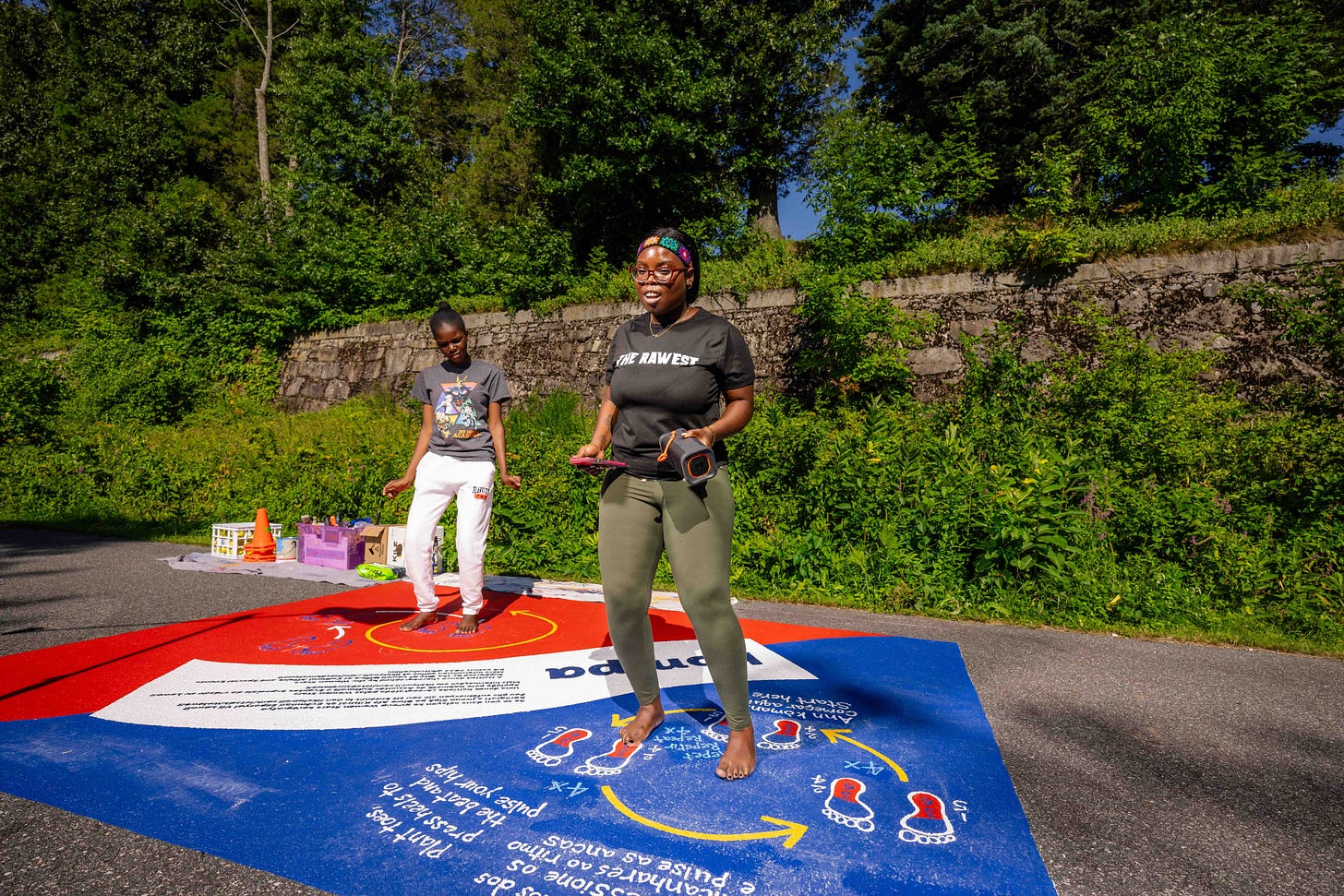In our last installment, I cracked the seal on the months-long paralysis preventing me from talking about my “Let’s Dance, Lowell!” project. (The culprit, as usual: caring too much.)
I told you all about my first mural in that series, LEGENDARY, a dance diagram mural choreographed by the captains of the Lowell High School Step Team. This is Volume 2 of I Dreamt My Paint Was Still Wet in Lowell (IDMPWSWIL for short), and I’ll cover the second mural I painted, “Salsa on 1.”
But first, let me immediately interrupt myself
I really did have that dream, by the way. The paint may be long dry, but to me the project doesn’t feel meaningfully complete until it has been properly documented and its collaborators properly celebrated in a way that can be easily cited, referenced, shared.
I’ve been thinking about that concept a lot lately – not just with my murals and art projects, but with my political work as well. For a lot of this term, I felt comfortable narrowing my focus on just the outcomes of my work (maybe that wasn’t a product of comfort so much of necessity, given my large workload). If a legislative result got broadcast, a moment recounted, a statement captured and shared, that was a nice bonus but not something I was focusing on.
Lately, I feel differently. In the immediate or material sense, it’s certainly true that winning the best policy outcomes and seeing them implemented is the most or only important thing.
But what do we lose – or leave on the table – by doing important work quietly? Broadcasting the wins, the fights, the process and the story, the reasons and the stakes, reminds people that who’s in which roles, and what resources and allies they have, really does make a difference. It reminds us that good stuff doesn’t happen by accident, and it reminds us just how hard it is to make good things come true.
If there’s one thing I’ve learned from being in office, it’s that it takes a large number of people working in tandem, deliberately, for quite a long time, to make anything positive happen; and it only takes one person to smash it all apart. Obviously we’re all seeing this fact play out in horrifying real time right now in the federal government, but I’ve also seen it happen in lots of ways locally from my one small vantage point on our City Council.
We’re all better armed for progress and success when we’re not naive to what a delicate balance all outcomes hang in – whether we’re talking politics, murals, or anything else.
So it’s not enough just to do the thing, you have to tell about it. Sharing ideas and wins builds reach and momentum for good ideas across jurisdictions (for example, cities picking up good ideas from one another – it happens all the time), and it inspires solidarity and action from other people (builds movements and deepens the bench).
If you want a good policy to stay in force, you have to make sure people know to celebrate and safeguard it – because administrations change. If you fought for your office, then you have to share your labors with your base so they’ll know they can’t take your seat for granted. And if you and your buddies worked out something very intricate and complex for people to step and dance and play upon, then you have to make sure it’s properly catalogued – because every helper deserves their curtain call, and because the story lasts longer than the paint does. The paint will fade. And you, or a different artist with a similar vision and goal, might benefit from having a blueprint to refer back to.
Community outreach and planning for “Let’s Dance, Lowell”
In the first installment of this recounting, I referred to a “suggestions-gathering” phase of the project. Indeed, of the eleven months that I worked on this project, the focus of first 5–6 months was mostly just talking to people in the community. I didn’t go into “Let’s Dance” with ideas for all the dances that would be represented, nor proposals for the eight locations around the City where dances would be painted (beyond the framework that each neighborhood would get one mural, which is how the City requested I structure it). The who, what and where of the series came out of input, ideas, and feedback from the community.
I went about my outreach phase through a combination of setting up meetings with community groups and liaisons; diffuse outreach like flyering and online promotion; and networking with people who were recommended to me as formal or informal community leaders and organizers. Between January and May, I met with so many people to ask for advice and ideas. I would ask about their work in the community – what group do they represent? what does that group do and why? what do they want me and other people to know about it? who’s involved? – and then transition into talking about my project. Mostly, I was asking for networking help. Who should I talk to in their neighborhood or network? Who would be interested? Who would want to give input? I would also ask for their opinion on important dance groups, if they had ideas – but a lot of the time, the recommendations were just about other people to consult.
Throughout this process, I was struck by people’s constant and generous willingness to share their time and their contacts. Some of the dozens of people that I met ended up being deeply involved with the project, and others helped extend my trail one breadcrumb further towards an eventual collaborator or a confirmed mural site. I had a lot of of one-on-ones and coffee meetings, canvassed at the Senior Center on Farmer’s Market day (cute!), presented the project at neighborhood action group meetings (kinda scary!), and I flyered at the library and arts spaces around town. I only scratched the surface of the city, but at the same time, this process served as a kind of crash course into Lowell – its arts, cultural, and service-provider communities especially. It inspired and energized me. From librarians to group directors to nonprofit rank and file to shop owners to the people managing the neighborhood listservs, everyone I met was doing everything they could to help their community.
The ultimate goal of all this outreach was to figure out where to paint and who to work with. In some neighborhoods, the question of mural site (where to paint) was very simple: for example, near the Reilly School was the first and best option for the mural in Belvidere, a suburban neighborhood with lots of single-family houses and few gathering places. Other sites felt intractable: for example, we finally got approval for the Pawtucketville neighborhood mural, which was to go on a DCR-controlled site, in October – after asking about it since May.
Even more crucially – because DCR woes aside, sidewalk is easier to come by dancers – while some collaborators were slow to find, others jumped off the page. From the very beginning of my outreach, when I started asking people what dances and dance groups they’d like to see represented in the mural series, people responded over and over, “Salsa in Lowell!” over and over. Duly noted!
SALSA ON 1
Salsa In Lowell is Franswa and Dawn, a prolific husband-and-wife duo who hold salsa dance lessons and organize salsa dance nights at Panela (RIP) on a weekly basis. Believe me when I say: they are utterly devoted to the craft, and I can only wonder at how many Lowellians they have taught to salsa over the years. The popularity of their salsa programming is well evidenced by how many people brought them up to me unprompted. Indeed, some were scandalized to learn that I hadn’t yet taken a class with them. It was clear that no dance mural series in Lowell would be complete without Franswa and Dawn being involved.
Franswa and Dawn performing the Salsa on 1 at our unveiling and art walk on November 9th. Photo courtesy of City of Lowell.
In the earlier months of my project, I was conscious of not locking in with choreographers too early, before I had done my suggestion-gathering due diligence. Eight slots is not that many, and I wanted to make sure that the final eight dances/dancers would make for the best, most inclusive, most representative slice of Lowell’s dance culture that would be possible under such limited and inherently non-comprehensive conditions.
But there were a couple obvious exceptions for dance groups that just had to be involved, whom I asked to take part immediately. Angkor Dance Troupe was one of those (more on them later in the series), and Salsa in Lowell was the other.
I first met up with Franswa and Dawn in March (at Coffee & Cotton, home of the best banana bread in the world, which has devastatingly shuttered along with the rest of Mill No. 5). They were characteristically gracious, enthusiastic, and engaged. They had lots of questions and suggestions about the project in general, and to my delight, they immediately agreed to be involved. Franswa even had a paper diagram of the basic Salsa step ready to go, which I pocketed and used in my drafting.
With this collaboration confirmed, for the next few months I turned my attention to dialing in on locations and filling out the rest of my choreographer roster. In the summer, I returned to Franswa’s diagram and began sketching. The salsa was one of the simplest to design of all the dances. Warm colors felt right for Latin dancing, and Franswa suggested decorating the mural with traditional salsa percussion instruments like the clave, tumbao, maracas, guiro, and cowbell, also sending me a link for the Salsa Beat Machine app, which is delightful to play around with.
This is a pre-final version of the mural design. It had to be lightly elongated after we assigned it to its location, the “credits” text was moved around, and all the text was translated into Spanish and Khmer as well as English.
After some deliberation, we decided that the Salsa mural would go in the Centralville neighborhood. On busy Bridge Street, there is a crosswalk that leads onto a walking path up a grassy rise to the back of the Robinson Middle School; and across Bridge Street is MacPherson Park. The mural was to be painted on the sidewalk on the school side of the street, close to the crosswalk and the path.
Like with the LEGENDARY mural, this was another location that was floated by the teens of the Lowll Boys & Girls Club and then corroborated by Jane from the Lowell Parks & Conservation Trust (or maybe it was the other way around). The City and I loved the idea of situating the mural on a walking route that is extremely well-used by students. Our goal was to place these murals where people would naturally encounter them in the paths they traveled in their day-to-day lives, and this suggestion fit that goal perfectly.
Aforementioned crosswalk and path at golden hour.
My dream team
I met a new friend, Levi, at a Centralville Neighborhood Action Group meeting early in the year when I was presenting about the “Let’s Dance, Lowell” series and soliciting feedback. He is a Lowell Public Schools paraprofessional who also single-handedly runs Community Connections, an afterschool program for middle schoolers. We immediately knew we wanted to collaborate in some way on the project. Initially we thought his youth team might choreograph one of the murals, but later we decided that it would be a better fit for the Community Connections kids to have a major painting role on one of the murals.
I can’t say enough good things about Levi and the Community Connections kids. They are focused, funny, mature, and very intent on being useful. With their assistance, we got this mural painted in record time – just three days.
Our first day onsite, we put down primer with rollers. As soon as that was dry, I described to them the grid that we needed to guide us in sketching the mural design to scale on the ground. Measuring tape in hand, they worked together in pairs getting the lines chalked out, dividing the mural surface into even sections. Together, we chalked out the mural elements – where the feet land, the boundaries of the colorful border shapes – using the grid lines to guide us. We verified our chalk sketches by eye and by dancing on them. Then it was time to open the paint cans and get out the brushes.
I was gobsmacked to get so much done in just one day, and to find my helpers so helpful. There are a lot of wonderful reasons to bring volunteers and assistants onto a mural site: education, morale, camaraderie, and community involvement, to name a few. But truthfully, speeding up my muraling process is not usually on that list.
I would have been pleased to share this site with Community Connections in any case: it was great fun to spend time with them, I was glad to create an opportunity for them to create public art in their neighborhood, and it greatly enriched the end result for them to have a hand in it. But it was certainly a great bonus that they were genuinely good assistants, and it was very special that they were present to experience nearly every stage of the mural-creation process, from primer to finishing touches.
On the second workday, I guided them in sketching and painting the decorative instruments. I was genuinely impressed by how good they were at the sketching in particular. It’s much easier to draw small (on a page) than big (an instrument as long as your arm).
Teaming up to sketch the tumbao.
On our third day onsite, an early finish was in my sights. Armed with all my stencils, me and my other assistant for the week – Sarah, visiting from Memphis and conscripted into mural service – arrived early and hunkered down on getting all of the text (title, instructions, credits) laid out and spray-painted before the kids arrived.
In retrospect, I have no doubt that they could have handled the stencils too. But as I was still getting used to this highly annoying and finicky technique myself, I was not ready to entrust it to other practitioners. Instead, they helped me finish painting the instruments, accent lines, and they got everyone’s names signed on the side of the mural.
All the good photos are by Henry Marte.
Like the LEGENDARY, this mural was also an unbelievably hot and sweaty affair (and loud – Bridge Street is a major thoroughfare for really big trucks). Big thanks to Levi for, in addition to everything else, bringing a canopy tent for us to take breaks under, and a boom box that could compete with the traffic. This guy thinks of everything.
Four short months later, we were back on the Salsa, partnered up and salsa-ing along with Franswa and Dawn on the mural they designed – though at a 90º angle to the footsteps, to have enough room for all the folks that came along for our bus tour of the eight mural sites.
PS: Folks who looked closely at the completed mural or design may have noticed beat 4 is conspicuously absent. Why? Beat 4 is where you pause in between phrases; no new footfalls occur. If you’re confused, you’ll just have to get yourself to one of Franswa and Dawn’s classes.
NEXT TIME
In my next installment, I will recap the Konpa mural, choreographed by the Women Stars dance troupe convened by the International Institute of New England, and painted in the South Lowell neighborhood by the Wamesit Falls, on a beautiful greenway maintained by the Lowell Parks & Conservation Trust.
Two Women Stars members checking my work-in-progress in August.
Thanks for reading!
If you enjoyed this newsletter, please consider forwarding to a friend and/or making a donation to one of the groups involved in this project.
Don’t be a stranger!
–Kit

